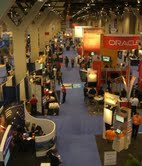 Define “Best of Breed.” That’s rhetorical, but think about it because it illustrates a point about the direction of HR software that was part of the “Great Technology Debate” at HR Tech this morning.
Define “Best of Breed.” That’s rhetorical, but think about it because it illustrates a point about the direction of HR software that was part of the “Great Technology Debate” at HR Tech this morning.
It wasn’t among the questions posed to debaters Jason Averbrook, CEO at Knowledge Infusion, and Gartner’s Managing VP Jim Holincheck, though it lurked behind their generally affable agreement on most of the talent management issues that arose during their time on stage.
For instance, when show co-chair and debate moderator Bill Kutik asked about the meaning of strategic human capital management, and, later, about just what workforce planning is, there wasn’t much debate.
The former is the linkage of employees, their skills, training, performance, management, compensation, and deployment directly to the business goals and needs of the enterprise. As Holincheck said, it is “more than talent management,” and as both agreed, it is well more than the mere automation of HR functions.
Workforce planning was a little more complicated.
Distilling what the two said, workforce planning is the collection and analysis of human capital metrics to produce actionable plans positively impacting the performance of the enterprise.
What happens, though, when you have multiple best-of-breed systems from different vendors? There’s lots of data being collected, but the first obstacle to using it is integrating it.
Holincheck observed that 30 percent of his firms did no core HR integration. One problem, one big problem, is, he said, that “HR is still siloed.”
Averbrook echoed the silo comment, pointing out that talent management and workforce planning is “measured by what value it brings.” The implication being that without stitching together all the data and linking it to business talent management is, if not useless for business planning, certainly of limited value.
It was at this point that the differing views of best of breed began to emerge. While neither of them articulated it quite this way, best of breed can be decided component by component. That’s pretty much what we have been doing for years.
Makes sense, no? If you’re going to buy a talent acquisition system, you want the best of breed. Or at least the best you can afford. Same for onboarding. Ditto for performance management, and so on.
The problem with that approach, as countless employers have discovered, is as Averbrook energetically observed: “Is there a way of pulling all this data together?”
“Do you have the IT support to go with a bifurcated approach? The vendors aren’t going to string it together for you.”
Another way of looking at best of breed is holistically. Even if each piece may not be the Rolls Royce in its field, does a vendor’s complete talent management suite do what you need it to do effectively, smoothly, efficiently, and work in a way that makes it easy for people to use? Then for you, that may be the best of breed.
The HR tech vendors have been sensing the shift to product suites for the last few years. It’s one reason why so many acquisitions and partnerships have been happening.
Not an hour after the Great Debate ended, I was talking with Terrence McCrossan, division VP marketing and strategy for ADP. We were talking about the growing HR software line from ADP and the morning’s debate.
“Convergence there,” he said, referring to the issue of suite vs. best of breed, “is a big one.” Customers are looking more and more, he agreed, to comprehensive solutions for all the reasons Averbrook cited.
None of this means second rate is acceptable. And the larger employers with the IT and financial resources to make things work together, will probably still take the component approach. However, it does mean we’re taking a broader view of what it means to be “best of breed.”
Once you have the data, however, you compile it. Then what do you do with it? Both debaters agreed that most of us are still in the early stages of making best use of the information the systems now give us.
One more observation from the debate: How do you introduce the social collaboration tools to your enterprise?
Averbrook counseled HR to “take the lead,” and not leave it to other departments or IT. “Start with it,” rather than add it incrementally to the work process.
Holincheck didn’t disagree with HR being involved, but he cautioned an incremental approach. Go slow. Let the use of social tools grow virally.
“I think it has to be part of the (TM) strategy, but I don’t think it has to be first.”